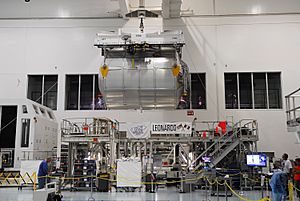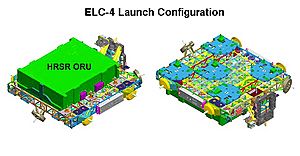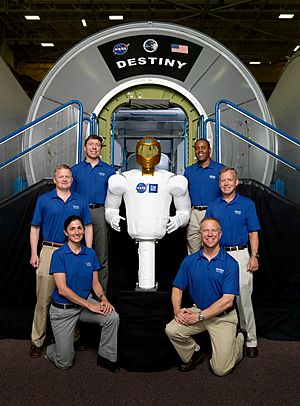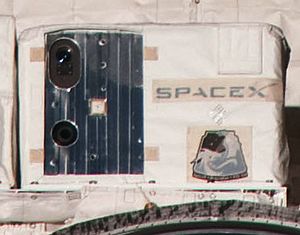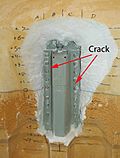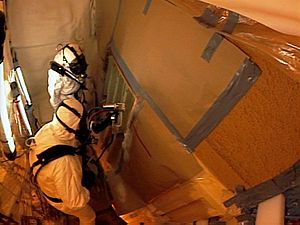STS-133 facts for kids
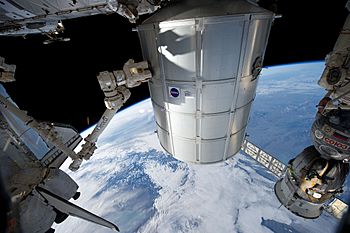
Canadarm2 installs the PMM Leonardo
|
|
| Mission type | ISS assembly |
|---|---|
| Operator | NASA |
| Mission duration | 12 days, 19 hours, 4 minutes, 50 seconds |
| Distance travelled | 8,536,190 kilometres (5,304,140 mi) |
| Spacecraft properties | |
| Spacecraft | Space Shuttle Discovery |
| Launch mass | Orbiter: 121,840 kilograms (268,620 lb) Stack: 2,052,610 kilograms (4,525,220 lb) |
| Dry mass | 92,867 kilograms (204,736 lb) |
| Crew | |
| Crew size | 6 |
| Members |
|
| Start of mission | |
| Launch date | 24 February 2011, 21:53:24 UTC |
| Launch site | Kennedy Space Center, LC-39A |
| End of mission | |
| Landing date | 9 March 2011, 16:58:14 UTC |
| Landing site | Kennedy SLF Runway 15 |
| Orbital parameters | |
| Reference system | Geocentric |
| Regime | Low Earth |
| Perigee | 208 kilometres (129 mi) |
| Apogee | 232 kilometres (144 mi) |
| Inclination | 51.6° |
| Period | 88.89 minutes |
| Epoch | 25 February 2011 |
| Docking with ISS | |
| Docking port | PMA-2 (Harmony forward) |
| Docking date | 26 February 2011, 19:14 UTC |
| Undocking date | 7 March 2011, 12:00 UTC |
| Time docked | 8 days, 16 hours, 46 minutes |
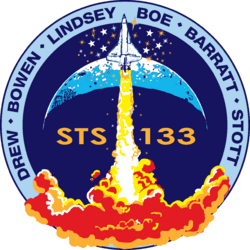 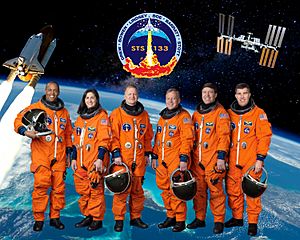 From left to right: Alvin Drew, Nicole Stott, Eric Boe, Steven Lindsey, Michael Barratt and Steve Bowen |
|
'STS-133 was a space mission by NASA's Space Shuttle program. During this mission, the Space Shuttle Discovery flew to the International Space Station (ISS). This was Discoverys 39th and final trip into space.
The mission launched on 24 February 2011, and landed on 9 March 2011. Six American astronauts, all of whom had flown in space before, were part of the crew. Steven Lindsey was the commander. The crew joined the astronauts already living on the space station as part of Expedition 26. Just before launch, one of the original crew members, Tim Kopra, was hurt in a bicycle accident. He was replaced by Stephen Bowen.
The mission carried several important items to the space station. These included the Permanent Multipurpose Module (PMM) Leonardo, which stayed attached to the station. The shuttle also brought the third ExPRESS Logistics Carrier (ELC) and a humanoid robot named Robonaut. This flight was the 133rd Space Shuttle mission and Discovery's last. Discovery spent a total of 365 days in space over its lifetime.
The launch of STS-133 was delayed many times. This was due to technical problems with the external fuel tank and some issues with the cargo. The launch was first planned for September 2010, but it was moved to October, then November, and finally to February 2011.
Contents
- What Did STS-133 Carry to Space?
- Meet the Crew of STS-133
- Important Moments for STS-133
- How the Crew Trained
- Preparing the Shuttle for Flight
- Launch Attempts
- Mission Timeline: A Day-by-Day Look
- Day 1: Launch Day (24 February)
- Day 2: Checking the Shuttle (25 February)
- Day 3: Docking with the ISS (26 February)
- Day 4: Preparing for Spacewalks (27 February)
- Day 5: Spacewalk 1 (28 February)
- Day 6: Installing Leonardo (1 March)
- Day 7: Spacewalk 2 (2 March)
- Day 8: Moving Cargo (3 March)
- Day 9: Crew Conference (4 March)
- Day 10: More Cargo Work (5 March)
- Day 11: Saying Goodbye to the ISS (6 March)
- Day 12: Undocking from the ISS (7 March)
- Day 13: Getting Ready for Landing (8 March)
- Day 14: Landing Day (9 March)
- Spacewalks During STS-133
- Wake-Up Calls from Space
- Images for kids
- See also
What Did STS-133 Carry to Space?
The Permanent Multipurpose Module (PMM) Leonardo
STS-133 delivered Leonardo to the space station. Leonardo is one of three Multi-Purpose Logistics Modules (MPLMs). It was left permanently attached to the ISS to add much-needed storage space. Leonardo launched with many supplies inside it.
The Italian Space Agency started building Leonardo in April 1996. It arrived at the Kennedy Space Center (KSC) in August 1998. Leonardo first flew on Discovery in 2001 as part of the STS-102 mission. Before STS-133, Leonardo had flown seven times as an MPLM.
After its last flight on STS-131, Leonardo was changed to stay on the space station for good. Some equipment was removed to make it lighter. Extra shielding was added to protect it from tiny space rocks or space junk. A special reflector was also added for the Japanese Space Agency (JAXA).
Once Leonardo was attached to the station, its contents were moved to other parts of the ISS. Later, empty launch hardware from Leonardo was put into Japan's Kounotori 2 (HTV-2) cargo ship. This cargo ship then burned up safely in Earth's atmosphere.
ExPRESS Logistics Carrier 4 (ELC-4)
The Express Logistics Carrier (ELC) is a strong platform. It holds equipment on the outside of the space station. On STS-133, Discovery carried ELC-4 to the station. It was placed on the station's right-side truss. ELC-4 weighed about 8,235 pounds (3,735 kg).
ELC-4 carried several spare parts. One main part was a Heat Rejection System Radiator (HRSR). This radiator is a spare for the station's cooling system.
Robonaut2: A Robot in Space
Discovery also carried Robonaut2 (R2), a humanoid robot, to the International Space Station. The weightless conditions in space are perfect for robots like R2 to work with astronauts. R2's first job was to help engineers learn how robots work in space. Later, it might help astronauts with spacewalks and science tasks. R2 was the first humanoid robot in space. It was stored inside the Leonardo module. After being unpacked, R2 started working in the Destiny module for testing.
R2 was first designed to be used on Earth. For its trip to the ISS, R2 got some upgrades. Its outer skin was changed to meet fire safety rules. Extra shielding was added to protect it from electronic interference and radiation. The fans were replaced with quieter ones. Its power system was changed to work with the station's power. R2 also went through tests to make sure it could handle the harsh conditions of space. It was also tested to make sure it could survive the vibrations during launch.
The robot weighs 300 pounds (140 kg). It is made of nickel-plated carbon fiber and aluminum. R2 is 3 feet 3.7 inches (100.8 cm) tall from its waist to its head. Its shoulders are 2 feet 7.4 inches (79.8 cm) wide. R2 has 54 motors and can move in 42 different ways. It runs on 38 PowerPC computer processors.
SpaceX DragonEye Sensor Test
Space Shuttle Discovery also carried a special sensor called DragonEye. This sensor uses Lidar (Light Detection and Ranging) to create 3D images. This was the third time a Space Shuttle helped the company SpaceX. The DragonEye on STS-133 had improvements from earlier versions. This test was a final check before it was fully used on SpaceX's Dragon spacecraft. The Dragon spacecraft had its first flight in December 2010.
The DragonEye sensor creates a 3D image by sending out a laser pulse. It measures how long it takes for the light to bounce back. This tells it how far away targets are and their direction. It can "see" targets that reflect light, like parts of the space station.
The DragonEye sensor was placed on Discoverys docking system. SpaceX collected data from DragonEye at the same time as Discoverys own sensor system. After the mission, SpaceX compared the data to see how well DragonEye worked.
The sensor was installed later than planned because of a problem with a laser part during testing.
Other Items Carried on STS-133
STS-133 carried the signatures of over 500,000 students. These students took part in the 2010 Student Signatures in Space program. This program was run by NASA and Lockheed Martin. Students added their signatures to posters in May 2010 as part of Space Day celebrations. They also learned about space in their classes. This program has been active since 1997. Nearly seven million student signatures have flown on ten Space Shuttle missions.
Discovery also carried hundreds of flags, bookmarks, and patches. These were given out after the shuttle returned to Earth. The mission also flew two small Lego Space Shuttles. This was to celebrate a partnership between Lego and NASA. Astronauts also brought personal items. These included medallions from their schools or military careers. There was also a William Shakespeare "action figure" and a stuffed giraffe mascot. T-shirts from a junior high school and a volunteer fire department were also on board.
Meet the Crew of STS-133
| Position | Astronaut | |
|---|---|---|
| Commander | Steven Lindsey Fifth and last spaceflight |
|
| Pilot | Eric Boe Second spaceflight |
|
| Mission Specialist 1 | Nicole Stott Second and last spaceflight |
|
| Mission Specialist 2 | Alvin Drew Second and last spaceflight |
|
| Mission Specialist 3 | Michael Barratt Second spaceflight |
|
NASA announced the STS-133 crew on 18 September 2009. Their training started in October 2009. The first crew included commander Steven Lindsey, pilot Eric Boe, and mission specialists Alvin Drew, Timothy Kopra, Michael Barratt, and Nicole Stott.
However, on 19 January 2011, about a month before launch, Stephen Bowen replaced Tim Kopra. Kopra was hurt in a bicycle accident. All six crew members had flown in space before. Five of them, everyone except commander Steven Lindsey, were chosen as astronauts in the year 2000.
Steven Lindsey, the mission commander, stepped down from his role as Chief of the Astronaut Office to lead this mission. For the first time, two crew members, Nicole Stott and Michael Barratt, were already in space when their new mission was announced. They were part of the Expedition 20 crew on the ISS. During STS-133, Alvin Drew became the last African-American astronaut to fly on the Space Shuttle.
-
Lindsey, far left, presents a montage to Barack Obama as crew members Barratt, Boe, Stott and Bowen look on.
Important Moments for STS-133
The STS-133 mission marked several key points:
- It was NASA's 164th crewed space flight.
- It was the 133rd shuttle mission since STS-1.
- It was the 39th and final flight of Discovery.
- It was the 35th shuttle mission to the ISS.
- It was the 108th mission after the Challenger accident.
- It was the 20th mission after the Columbia accident.
How the Crew Trained
Practice for Launch Day
On 12 October 2010, the STS-133 crew arrived at the Kennedy Space Center. They were there to do the Terminal Countdown Demonstration Test (TCDT). This test was like a dress rehearsal for the launch. It trained both the crew and the launch team. They practiced everything that would happen in the final hours before launch, except the actual liftoff.
During the TCDT, the crew did many exercises. This included rescue training and a full launch day simulation. Commander Steve Lindsey and Pilot Eric Boe also practiced emergency landings in a special training aircraft. The crew also got a briefing from NASA engineers. This briefing explained all the work done on Discovery for the STS-133 mission. After finishing all the TCDT tasks, the crew went back to the Johnson Space Center on 15 October 2010.
The six astronauts returned to Kennedy Space Center on 28 October 2010. They flew in NASA T-38 training jets for their final preparations before launch.
-
Launch Pad 39A during the Terminal Countdown Demonstration Test.
On 15 January 2011, Tim Kopra, who was supposed to lead the spacewalks, was hurt. He had a bicycle accident near his home in Houston and broke his hip. Stephen Bowen replaced him on 19 January 2011. This change did not affect the planned launch date. This was one of the latest times a Space Shuttle crew member had to be replaced before a launch.
Preparing the Shuttle for Flight
STS-133 was first planned to launch on 16 September 2010. In June 2010, the launch date was moved to the end of October 2010. STS-133 was then set to fly before STS-134. This mission had the longest time spent in the Vehicle Assembly Building (VAB) since STS-35.
Discovery was moved from its hangar to the huge 52-story Vehicle Assembly Building (VAB) on 9 September 2010. The shuttle left its hangar at 6:54 AM EDT and was in the VAB by 10:46 AM EDT. This was Discovery's 41st move. The move was first planned for 8 September 2010, but it was delayed because of a broken water pipe near the VAB.
Inside the VAB, engineers used a large crane to lift Discovery upright. The orbiter was then lifted into the high bay. There, its external tank (ET-137) and solid rocket boosters were waiting to be attached. During this process, a nut inside the orbiter's back section fell out of place. Engineers worried they might have to move the orbiter back to a horizontal position to fix it. But they were able to reach the area and fix the nut. The orbiter was fully attached to its external tank on 11 September 2010.
The shuttle's move to the launch pad was planned for 20 September 2010. NASA invited over 700 shuttle workers and their families to watch. Discovery started its 3.4-mile trip from the VAB to Pad 39A earlier than planned, at 7:23 PM EDT. It took about six hours to reach the pad. The shuttle was secured on the launch pad by 1:49 AM EDT the next day.
Problems with the Fuel Tank
Orbital Maneuvering System (OMS) Vapor Leak
On 14 October 2010, engineers found a small leak in a fuel line for Discovery's orbital maneuvering system (OMS) engines. They smelled a "fishy" odor, which meant fuel vapor was in the air. The leak was found where two fuel lines met in the shuttle's back section. This line carried monomethyl hydrazine (MMH) fuel, which helps ignite the OMS engines.
Engineers replaced a cap, but the leak continued. They believed the leak was in the crossfeed flange area, a problem with the seals. On 18 October 2010, engineers tightened bolts around the leaky part. But tests still showed a leak. To fix it, they had to drain both OMS fuel tanks. On 23 October 2010, engineers successfully replaced two seals on the right OMS crossfeed flange. Tests showed the new seals were working. This allowed them to plan for a 1 November 2010 launch.
Main Engine Controller Issue
On 2 November, while getting Discovery ready for launch, engineers found an electrical problem. It was with the backup Main Engine Controller (MEC) on Engine No. 3. The problem seemed to be solved, but then another issue came up. This was thought to be "transient contamination" in a circuit breaker.
After more checks, the controller powered up normally. But then an unexpected voltage drop happened. Because of this, managers decided to delay the launch for at least 24 hours to figure out the problem.
Ground Umbilical Carrier Plate (GUCP) Leak
On 5 November 2010, during a launch attempt, a hydrogen leak was found at the Ground Umbilical Carrier Plate (GUCP). This plate connects the external tank to a pipe that carries hydrogen gas away. The leak was first detected during fueling. It was similar to leaks seen on earlier missions, but stronger.
After making the tank safe, engineers inspected the GUCP. They found that an internal seal was unevenly pressed. The quick disconnect hardware also seemed to fit poorly. These issues did not match earlier measurements.
On 12 November, teams started installing a new GUCP. This new plate had been tested before and showed better alignment. Technicians took extra measurements to make sure the new GUCP was perfectly aligned.
Cracks in the External Tank
More checks of the tank showed cracks in the foam insulation. These cracks were found in the area between the intertank and the liquid oxygen tank. They likely happened about an hour after the super-cold fuel started flowing into the tank for the 5 November launch attempt. These were the first cracks found at the launch pad.
Engineers cut away the insulation to look closer. They found two more 9-inch metal cracks under a structural rib called "stringer S-7-2". NASA managers decided to cut away more foam. They found two more cracks on a nearby stringer, S-6-2. These cracks seemed less severe. No cracks were found on the right side. NASA thought the lightweight aluminum-lithium alloy used in the tanks might have caused the cracks.
Repairs began while the shuttle was still on the pad. A special cover was built around the damaged area to help with repairs and apply new foam insulation. On 18 November, technicians installed new metal sections, called "doublers," to replace the cracked stringers. These doublers were twice as thick, adding strength.
Scanning of the stringers was finished on 23 November. NASA also scanned other parts of the tank.
Program managers identified the repairs needed to launch the shuttle safely. This was reviewed at a meeting on 24 November. Managers announced that the early December launch window would be missed. A new target date of 17 December was set, but they warned it could slip to February 2011. The 17 December date was preferred because the shuttle could carry more oxygen to the ISS.
Johannes Kepler ATV Rescheduled
The launch date of 24 February 2011 was officially set after a review meeting on 18 February 2011. All previous problems, including the fuel line leak and tank cracks, were resolved. There was a rule that required a 72-hour gap between dockings at the ISS. This could have delayed STS-133 because the ESA's uncrewed Johannes Kepler ATV supply craft was also delayed. However, managers decided to continue with the countdown. If docking issues arose with the ATV, STS-133 would wait for 48 hours. The Kepler ATV docked successfully on 24 February 2011, just before Discovery's launch.
Launch Attempts
| Attempt | Planned | Result | Turnaround | Reason | Decision point | Weather go (%) | Notes |
|---|---|---|---|---|---|---|---|
| 1 | 1 Nov 2010, 4:40:00 pm | scrubbed | — | technical | 29 Oct 2010, 10:00 am (T-11 hour hold) | 80% | OMS pod leak |
| 2 | 2 Nov 2010, 4:18:00 pm | scrubbed | 0 days, 23 hours, 38 minutes | technical | (T-11 hour hold) | 70% | OMS pod leak |
| 3 | 3 Nov 2010, 3:52:00 pm | scrubbed | 0 days, 23 hours, 34 minutes | technical | 2 Nov 2010, 5:40 am (T-11 built-in hold) | 70% | Electrical fault in backup SSME controller. |
| 4 | 4 Nov 2010, 3:29:54 pm | scrubbed | 0 days, 23 hours, 38 minutes | weather | 4 Nov 2010, 6:25 am | 20% | Decision made at pre-tanking weather briefing to reset clock to T-11 hold and delay ~24 hours due to rainy conditions. |
| 5 | 5 Nov 2010, 3:04:01 pm | scrubbed | 0 days, 23 hours, 34 minutes | technical | 5 Nov 2010, 12:00 pm (T-6 hold) | 60% | Hydrogen leak detected at ground umbilical carrier plate (GUCP) |
| 6 | 24 Feb 2011, 4:53:24 pm | success | 111 days, 1 hour, 49 minutes | 90% | The clock was held at T-5 minutes to allow time to resolve a computer issue at the Range Safety Officer's console. The issue was resolved and the clock restarted in time to allow Discovery to launch with just two seconds left in the launch window. |
Mission Timeline: A Day-by-Day Look
Day 1: Launch Day (24 February)
Space Shuttle Discovery successfully launched from Kennedy Space Center's Launch Pad 39A. It lifted off at 4:53:24 PM EST on 24 February 2011. The launch was delayed by 3 minutes due to a small computer problem. Once cleared, Discovery reached orbit in 8 minutes and 34 seconds.
About four minutes into the flight, a piece of foam broke off the External Tank. This foam was not a danger because it came off after the shuttle left Earth's atmosphere. NASA engineers also saw three more pieces of foam come off. These also happened when debris could not seriously harm the shuttle. Engineers believed this was due to "cryo-pumping." This happens when liquid hydrogen in the tank causes trapped air to turn into liquid. As the tank warms up, the liquid air turns back into gas, creating pressure that can make foam break off.
Once in orbit, the crew opened the payload bay doors. They turned on the Ku band antenna for fast communication with Mission Control. Astronauts Alvin Drew and Eric Boe also activated the Shuttle Remote Manipulator System (SRMS), also known as the Canadarm. Later, images of the External Tank during launch were sent down for analysis.
Day 2: Checking the Shuttle (25 February)
On Flight Day 2, the Discovery crew began getting ready to dock with the International Space Station. The day started with a firing of the Orbital Maneuvering System (OMS) engine. This helped Discovery catch up to the ISS. Commander Steve Lindsey, Pilot Eric Boe, and Mission Specialist Al Drew inspected the heat-resistant panels with the Orbital Boom Sensor System (OBSS). This inspection took about six hours. Drew, Michael Barratt, and Steve Bowen prepared their two Extravehicular Mobility Units (EMUs) for the two spacewalks planned for the mission. Later, the crew checked the tools they would use to meet the station. Another OMS engine firing happened at the end of the day.
Day 3: Docking with the ISS (26 February)
The orbiter docked with the ISS on Flight Day 3. This was the 13th time Discovery had visited the ISS. Docking happened on time at 7:14 PM UTC. Connecting the two vehicles was delayed by about 40 minutes because of movement between the station and shuttle. The hatches finally opened at 9:16 PM UTC, and the Expedition 26 crew welcomed the STS-133 crew.
After the welcome, the crew's main task was to move the ExPRESS Logistics Carrier 4 (ELC-4). ELC-4 was taken from Discovery's payload bay by the Space Station Remote Manipulator (SSRMS), also known as Canadarm2. Nicole Stott and Michael Barratt operated it. The SSRMS then handed ELC-4 to the Shuttle Remote Manipulator System (SRMS), controlled by Boe and Drew. The SSRMS then moved ELC-4 to its spot on the S3 truss. ELC-4 was fully installed at 3:22 AM UTC on 27 February. While the robots were working, Bowen and Lindsey moved items needed for the next day and the spacewalk.
Day 4: Preparing for Spacewalks (27 February)
On Flight Day 4, Stott and Barratt used the Canadarm2 to grab the Orbiter Boom Sensor System (OBSS). They removed it from Discovery's payload bay. The OBSS was then handed to the Shuttle Remote Manipulator System. The space station arm had to grab the OBSS because the shuttle arm couldn't reach it. This was done to move it out of the way so the Permanent Multipurpose Module (PMM) could be removed.
After the OBSS was moved, the STS-133 crew joined ISS Expedition 26 commander Scott Kelly and flight engineer Paolo Nespoli. They did several interviews with media outlets. The crew also continued moving cargo to and from the ISS. Throughout the day, Drew and Bowen prepared tools for their spacewalk on Flight Day 5. Later, they reviewed the spacewalk procedures with the shuttle and ISS crews. After the review, Bowen and Drew put on oxygen masks and entered the Quest airlock. This was for their "campout" to help prevent decompression sickness.
Day 5: Spacewalk 1 (28 February)
Steve Bowen and Alvin Drew performed the mission's first spacewalk (EVA) on Flight Day 5. They started their EVA preparations after waking up. A conference was held with Mission Control. Bowen and Drew switched their spacesuits to internal power at 10:46 AM EST. This marked the start of EVA 1.
During the spacewalk, Bowen and Drew installed a power cable. This cable connected the Unity and Tranquility modules. It provided a backup power source. They then moved a broken ammonia pump to a storage platform. This pump had been replaced in August 2010. Operations with the robotic arm were delayed due to technical problems with the control station.
After installing a wedge under a camera and doing a Japanese experiment called "Message in a Bottle," the spacewalk ended. It lasted six hours and 34 minutes.
Day 6: Installing Leonardo (1 March)
Flight Day 6 saw the installation of the Leonardo Permanent Multipurpose Module (PMM). It was attached to the Earth-facing port of the station's Unity module. Once installed, work began to connect Leonardo to the ISS as a permanent module. Bowen and Drew reviewed the procedures for the mission's second spacewalk. They then began their pre-EVA "campout" in the Quest airlock.
Day 7: Spacewalk 2 (2 March)
Bowen and Drew conducted STS-133's second spacewalk on Flight Day 7. Drew removed thermal insulation from a platform. Bowen swapped out an attachment bracket on the Columbus module. Bowen then installed a camera on the Dextre robot and removed insulation from Dextre's electronics. Drew installed a light on a cargo cart and fixed some loose insulation on a valve. Meanwhile, the ISS and shuttle crew entered the Leonardo PMM to start moving items inside.
Day 8: Moving Cargo (3 March)
On Flight Day 8, the crew began moving cargo from the Leonardo PMM into the ISS. The crew also had some free time on this day.
Day 9: Crew Conference (4 March)
On Flight Day 9, the equipment used during Drew and Bowen's spacewalk was reorganized. A joint news conference with both crews was held via satellite. After this, the crew had more free time.
Day 10: More Cargo Work (5 March)
The crew continued to move items inside the Leonardo PMM on Flight Day 10. A photo shoot of the ISS with multiple spacecraft docked was considered, but not done.
Day 11: Saying Goodbye to the ISS (6 March)
The crew continued working inside the Leonardo Permanent Multipurpose Module. They also checked Discovery's tools for leaving the station. The shuttle crew said their goodbyes to the ISS crew. They then left the station and sealed the hatch between the orbiter and the ISS. A center-line camera was also installed on this day.
Day 12: Undocking from the ISS (7 March)
Discovery undocked from the ISS for the final time on Flight Day 12. It then flew around the station one last time before moving away. A final inspection of Discovery's Thermal Protection System was done using the OBSS. After this, the OBSS was put away.
Day 13: Getting Ready for Landing (8 March)
The Discovery crew stored their equipment inside the shuttle. They then checked the flight control system and tested the reaction control system. A final briefing for deorbit preparations was held. The shuttle's Ku band antenna was then put away.
Day 14: Landing Day (9 March)
On the final day of the mission, Discovery's crew finished preparing for deorbit. They closed the shuttle's payload bay doors. A successful deorbit burn and re-entry ended with Discovery landing at Kennedy Space Center's Shuttle Landing Facility for the last time. It landed on 9 March 2011, at 11:58:14 AM EST. The shuttle was officially retired when its wheels stopped. This was the last shuttle landing to happen during daylight hours.
Spacewalks During STS-133
Two spacewalks (EVAs) were done during the mission.
| EVA | Spacewalkers | Start (UTC) | End (UTC) | Duration |
|---|---|---|---|---|
| EVA 1 | Steve Bowen Alvin Drew |
28 February 2011 15:46 |
28 February 2011 22:20 |
6 hours 34 minutes |
| Drew and Bowen installed a power cable between the Unity and Tranquility modules. This provided a backup power source. They then moved a broken ammonia pump from its temporary spot to the External Stowage Platform 2. Drew and Bowen also installed a wedge under a camera on the S3 truss. This gave clearance from the new ELC-4. They also replaced a guide for the rail cart system used by the station's robotic arm. Their last task was to "fill" a special bottle with the vacuum of space for a Japanese educational project. | ||||
| EVA 2 | Steve Bowen Alvin Drew |
2 March 2011 15:42 |
2 March 2011 21:56 |
6 hours 14 minutes |
| Drew removed thermal insulation from a platform. Bowen swapped out an attachment bracket on the Columbus module. Bowen then installed a camera on the Dextre robot and removed insulation from Dextre's electronics platform. Drew installed a light on a cargo cart and fixed some loose thermal insulation on a valve. | ||||
Wake-Up Calls from Space
NASA started a tradition of playing music to astronauts during the Gemini program. The first time music was used to wake up a crew was during Apollo 15. Each song is specially chosen, often by the astronauts' families. It usually has a special meaning to an astronaut or relates to their daily tasks.
For STS-133, NASA let the public vote on two songs to wake up the crew.
| Flight Day | Song | Artist | Played for | Links |
|---|---|---|---|---|
| Day 2 | "Through Heaven's Eyes" | Brian Stokes Mitchell | Michael R. Barratt | WAV, MP3 |
| Day 3 | "Woody's Roundup" | Riders in the Sky | Alvin Drew | WAV, MP3 |
| Day 4 | "Java Jive" | The Manhattan Transfer | Steven Lindsey | WAV, MP3 |
| Day 5 | "Oh What a Beautiful Morning" | Davy Knowles & Back Door Slam | Nicole Stott | WAV, MP3 |
| Day 6 | "Happy Together" | The Turtles | Stephen Bowen | WAV, MP3 |
| Day 7 | "Speed of Sound" | Coldplay | Eric Boe | WAV, MP3 |
| Day 8 | "City of Blinding Lights" | U2 | STS-133 Crew | WAV, MP3 |
| Day 9 | "The Ritual/Ancient Battle/2nd Kroykah" | Gerald Fried - (Composer) | STS-133 Crew | WAV, MP3 |
| Day 10 | "Ohio (Come Back to Texas)" | Bowling for Soup | STS-133 Crew | WAV, MP3 |
| Day 11 | "Spaceship Superstar" | Prism | STS-133 Crew | WAV, MP3 |
| Day 12 | Theme to "Star Trek" | Voice-over by William Shatner Song by Alexander Courage |
STS-133 Crew | WAV, MP3 |
| Day 13 | "Blue Sky" (Live) | Big Head Todd and the Monsters | STS-133 Crew | WAV, MP3 |
| Day 14 | "Coming Home" | Gwyneth Paltrow | STS-133 Crew | WAV, MP3 |
Images for kids
See also
 In Spanish: STS-133 para niños
In Spanish: STS-133 para niños


